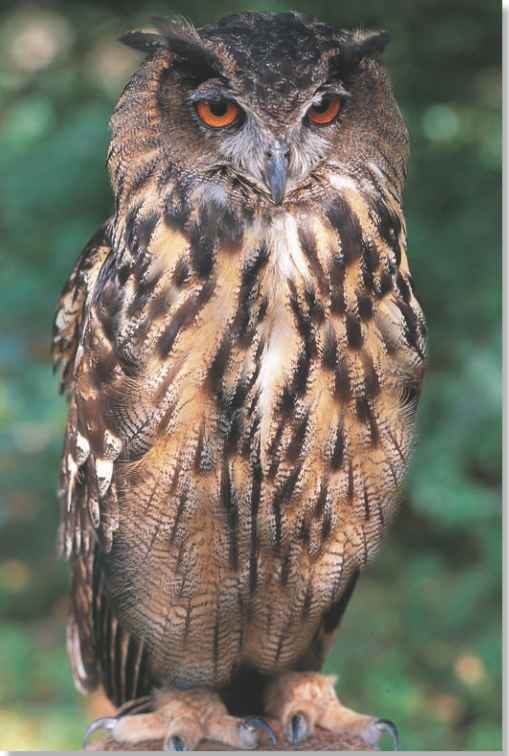ORDER
Strigiform.es
FAMILY
Strigidae
GENUS & SPECIES
KEY FEATURES
• The world’s largest : owl, but very shy and elusive despite its great size and fearsome appearance
• Highly sensitive ears can detect the faintest sounds of prey at a distance of 30′ and then pinpoint its position even in total darkness
• It can tackle prey as large as hares and ducks, killing its quarry with its deadly curved talons
WHERE IN THE WORLD?
From the Iberian peninsula and North Africa east through Europe, the Middle East, central Asia, including India, as far as Siberia and China; rare or uncommon across most of its range

Lifecycle
When darkness falls, the huge eagle owl launches from its roost to take on the role of top avian predator of the night, replacing the day-hunting eagles that give it its name.
HABITAT
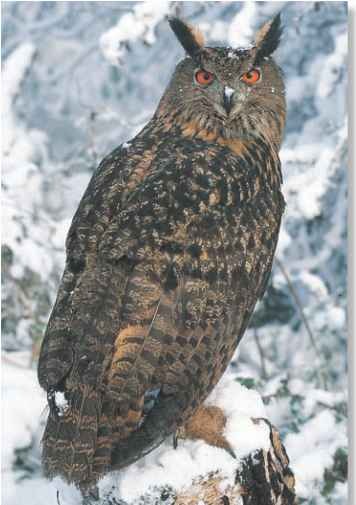
A Snowy wastes Winters are harsh in the eagle owl’s wide range.
The eagle owl lives in remote wilderness areas far from human activity. Only large tracts of undisturbed land can
provide a sufficient and reliable food supply for this predator.
A variety of habitats support the eagle owl, from northern coniferous forests, temperate woodlands, steppes and deserts. It prefers rocky terrain, roosting and nesting on cliff faces.
BREEDING
Eagle owls begin breeding in mid- or late winter. This owl doesn’t build a nest; eggs are laid on cliff ledges or rocky slopes. Incubation often begins when there’s still fresh snow on the ground. This early start means that the young will fledge in time to feed on unwary animals that are preoccupied with spring courtship and nesting or are just emerging from hibernation.
After hatching, young are brooded by the female for two weeks. During this time, the male brings food until the young fledge about six weeks later.
# Eagle owls can be cannibalistic. The youngest and weakest chick may be killed and then devoured by its parents and siblings.
If daytime birds notice a roosting eagle owl, they attack it. After repeated dive-bomb attacks, the owl takes cover elsewhere.
# The eagle owl’s deep, mournful wooo call carries for 3 miles so it can keep contact in large territories.
FOOD & HUNTING
The eagle owl is most active after dusk and before dawn. Shortly after sunset, it leaves its daytime roost and flies off to hunt. Perched in a tree, it waits patiently for the chance to make a kill.
Small rodents, especially voles, make up the eagle owl’s diet, but it also seizes larger victims, such as ducks, grouse, rabbits and hares. Among more unusual prey are other predatory birds, notably smaller owls.
The owl regurgitates mucous-covered pellets containing the hair, bones and feathers that it’s unable to digest. Piles of pellets often gather under a favorite perch.
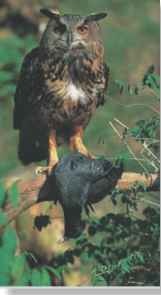
A Deathly silence Special wing feathers silence the owl’s attack.
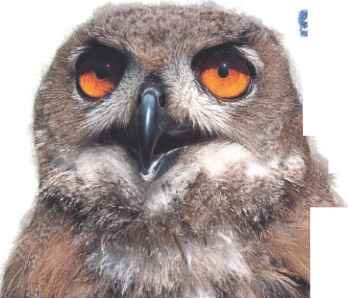
Slow developer Young eagle owls are
Larger than life independent 12 weeks Threat postures after fledging. intimidate intruders.
DEATH IN THE DARK
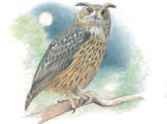
1 All ears…
Constantly alert, the eagle owl listens for sounds that may betray prey — either a faint rustling in a tree or in the leaf litter below.
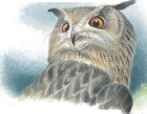
2 About turn…
Its keen ears detect movement in a tree behind it.Turning its head 180°, the eagle owl pinpoints the sound’s source…
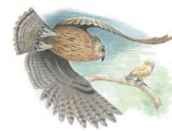
3 Ghostly glide…
… a barn owl. It glides swiftly yet silently to its unsuspecting prey. Even the barn owl’s own acute hearing fails to detect the eagle owl in time.
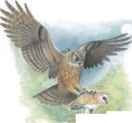
4 Fatal strike
Thrusting its long legs forward, the eagle owl strikes its victim, piercing it with its sharp talons and killing it almost instantly.
BEHAVIOR
Sedentary and territorial, the eagle owl moves only to escape severe winter weather, when its food supply is reduced. In Norway, owls may fly 1 20 miles to the coast to avoid the cold, exchanging their normal diet of mammals for one of seaducks and seabirds.
Despite its barrel-chested, fierce appearance, the eagle owl is very shy and is rarely seen, even when it flies by daylight. Due to years of persecution, it won’t tolerate human presence and quickly takes cover in trees or rock crevices. A cornered bird, however, faces an intruder with its feathers ruffled and wings held over its back to make itself appear bigger.
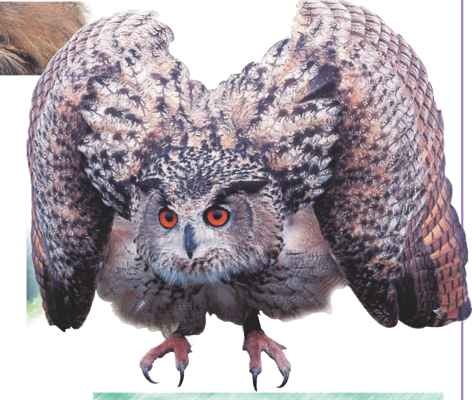
CONSERVATION
Like many poorly understood night birds, the eagle owl has been the victim of ignorance. During the 19th century, the species declined dramatically over most of its range, due mainly to the destruction of its eggs and young by farmers and gamekeepers. Today, legal protection and projects to release birds into areas from which they had vanished, such as Germany, have helped some populations recover. But as it needs large feeding territories and is so wary of humans, the species is likely to remain scarce over much of its range.
Profile
Eagle Owl
With exceptional hearing and special feathers for silent flight, the eagle owl swoops in surprise attacks, killing prey with its lethal talons.
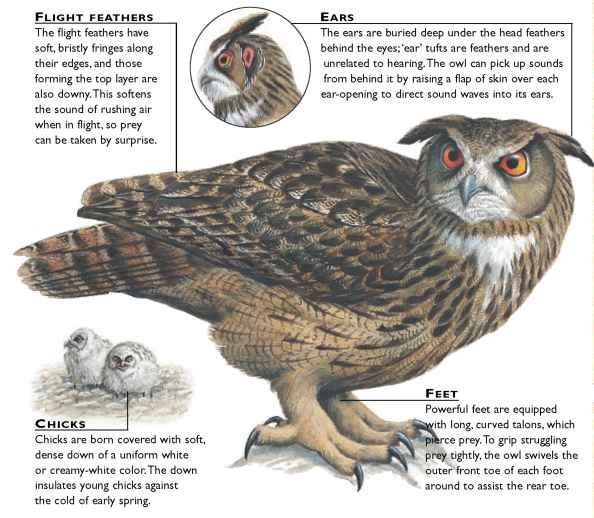
CREATURE COMPARISONS
The great gray owl (Stranebulosa) vies with the eagle owl for the title of the world’s largest owl. But their similarity in size is deceptive — the great gray is lighter and not as powerful. Its dense plumage, needed for harsh winters of northern forests, accounts for much of its bulk.
The great gray’s huge head is even larger viewed head-on; its yellow eyes are set close together in a round facial disc.The eagle owl’s orange eyes are set in a flatter-shaped facial disc.
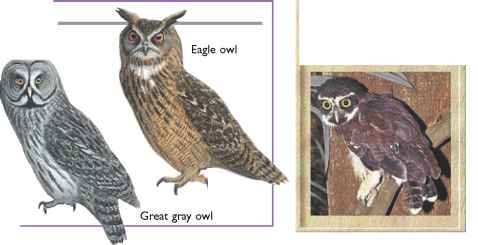
| VITAL | |
| STATISTICS | |
| Weight | 4-9 lbs. |
| Length | 2-2.5′ |
| Wingspan I Sexual [ Maturity |
5-7′ 2-3 years |
| Breeding . j Season | February . -August |
| Number 1 of Eggs | 1-6, but usually 2 or 3 |
| Incubation j Period | 34-36 days |
| Fledging [ Period | 50-60 days |
| Breeding ; Interval | .. 1 year |
| Typical ! Diet | Mammals from small rodents to adult hares; birds up to the size of ducks |
| Lifespan | 20 years |
RELATED SPECIES
• The family Strigidae contains nearly all the owls. The 14 species of eagle owl are the largest; pygmy owls are the ;* smallest. The spectacled owl (below) lives in South American forests.
